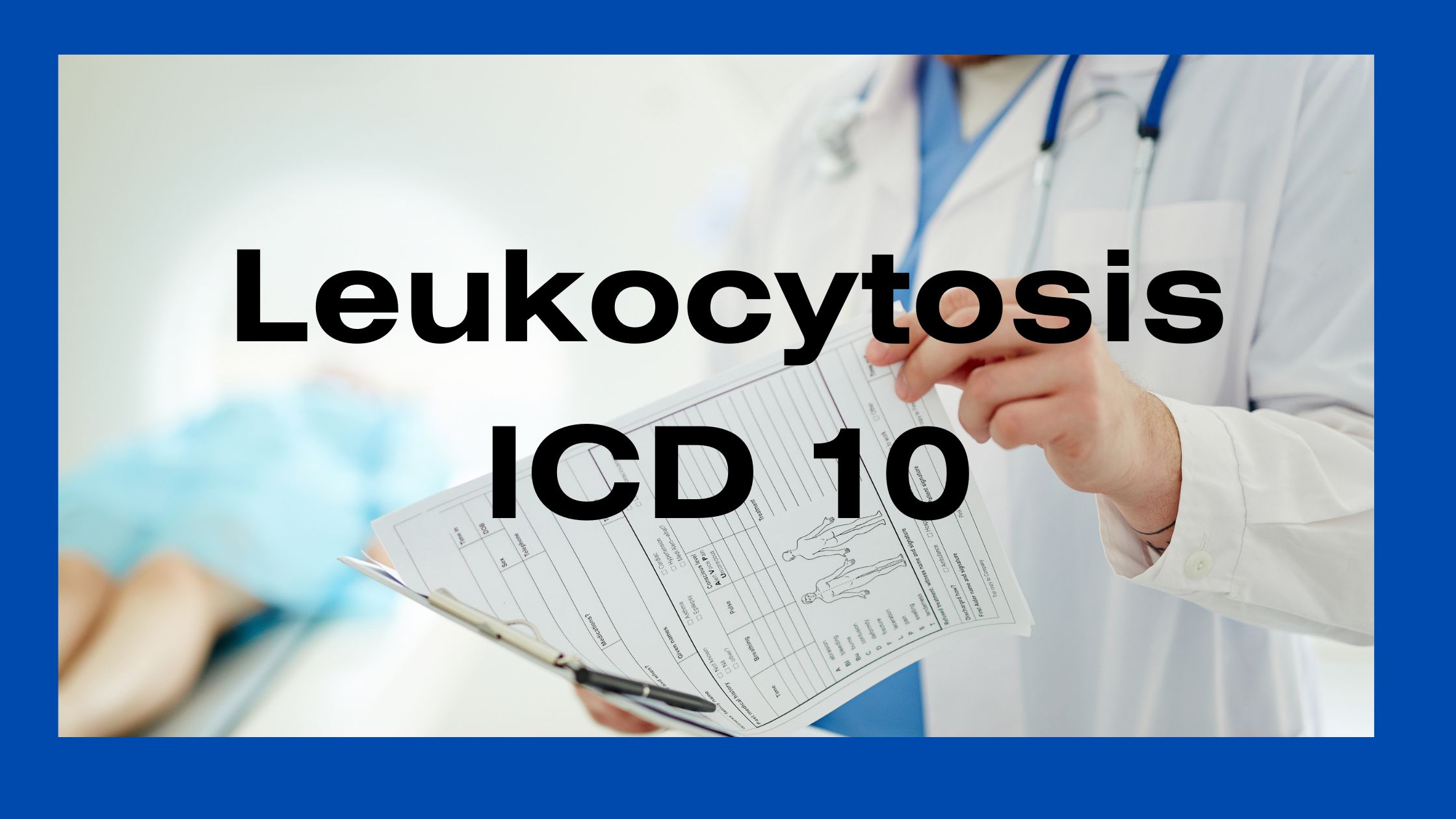Leukocytosis is a medical condition characterized by increased white blood cells (leukocytes) in the bloodstream. This condition is an important indicator of an underlying health issue and is commonly diagnosed using the International Classification of Diseases (ICD), 10th Revision (ICD 10). This article provide the details of Leukocytosis ICD 10, specifically D72.829, including its causes, symptoms, and available treatment options.
Understanding ICD 10 Leukocytosis , D72.829
ICD 10 is a global system used for diagnostic coding in healthcare. It provides a standardized way of classifying diseases, including leukocytosis. D72.829 is the ICD 10 code assigned to leukocytosis, which falls under the Other specified disorders of white blood cells. Other related Leukocytosis ICD 10 codes as mentioned as below,
D72.818 Other Decreased White Blood Cell Count: This code is used to indicate cases where a patient has a lower than normal count of white blood cells (leukocytes) in their bloodstream. This could be due to various reasons such as bone marrow disorders, infections, chemotherapy, radiation therapy, autoimmune diseases, or certain medications.
D72.819 Unspecified Decreased White Blood Cell Count: This code is used when the specific reason for the decreased white blood cell count is not known or not specified in the medical documentation.
D72.82 Elevated White Blood Cell Count: This code is used to indicate cases where a patient has a higher than normal count of white blood cells (leukocytes) in their bloodstream. Elevated white blood cell counts can be caused by infections, inflammation, stress, certain medications, bone marrow disorders, or other underlying health conditions.
D72.820 Lymphocytosis (Symptomatic): Lymphocytosis refers to an elevated level of lymphocytes, a type of white blood cell, in the blood. This code is used when the lymphocytosis is causing noticeable symptoms or is considered clinically significant.
D72.821 Monocytosis (Symptomatic): Monocytosis refers to an elevated level of monocytes, a type of white blood cell, in the blood. This code is used when the monocytosis is causing symptoms or is considered clinically significant.
D72.822 Plasmacytosis: Plasmacytosis is the presence of an abnormally high number of plasma cells, a type of white blood cell, in the blood or bone marrow. It is often associated with conditions like multiple myeloma. This code is used when plasmacytosis is present and causing concern.
D72.823 Leukemoid Reaction: A leukemoid reaction is a condition in which the body produces an excessive number of white blood cells, similar to what is seen in leukemia. It’s usually a response to severe infections, inflammation, or other underlying conditions. This code is used when a leukemoid reaction is diagnosed.
D72.824 Basophilia: Basophilia is the presence of an increased number of basophils, a specific type of white blood cell, in the bloodstream. This can be associated with certain chronic myeloid disorders. The code is used when basophilia is diagnosed.
D72.825 Bandemia: Bandemia refers to an elevated number of immature white blood cells called band cells (band neutrophils) in the blood. It’s often indicative of an acute infection or inflammatory process. This code is used when bandemia is documented.
D72.828 Other Elevated White Blood Cell Count: This code is used when a patient has an elevated white blood cell count that doesn’t fit into the specific categories mentioned earlier.
D72.89 Other Specified Disorders of White Blood Cells: This code is used for specific white blood cell disorders that are not covered by the previously mentioned codes. It might include less common conditions affecting white blood cells.
D72.9 Disorder of White Blood Cells, Unspecified: This code is used when there is a disorder involving white blood cells, but the specific diagnosis is not provided or known.
D73 Diseases of Spleen: This category covers various conditions related to the spleen.
D73.0 Hyposplenism: Hyposplenism indicates reduced splenic function, which can lead to an increased susceptibility to infections, particularly those caused by encapsulated bacteria.
D73.1 Hypersplenism: Hypersplenism refers to an overactive spleen that can lead to the premature destruction of blood cells (red blood cells, white blood cells, and platelets), resulting in anemia, leukopenia, and thrombocytopenia.
D73.2 Chronic Congestive Splenomegaly: This code is used for cases where the spleen is enlarged due to chronic congestion, often seen in conditions like cirrhosis and portal hypertension.
D73.3 Abscess of Spleen: This code is used when there is a localized collection of pus (abscess) within the spleen, usually caused by infection.
D73.4 Cyst of Spleen: This code is used when there is a cystic structure within the spleen, which can be either congenital or acquired.
D73.5 Infarction of Spleen: Infarction of the spleen occurs when blood supply to a portion of the spleen is compromised, leading to tissue death. This can occur due to various reasons, including blood clot or embolism.
D73.8 Other Diseases of Spleen: This code is used for other specific diseases or conditions affecting the spleen that are not covered by the previous codes.
Causes of Leukocytosis
Leukocytosis can be caused by various factors, ranging from infections to certain medical conditions. Some common causes include:
1. Infection: Bacterial, fungal, viral infections can stimulate the production of white blood cells (WBC), leading to leukocytosis. Examples include pneumonia, urinary tract infections, and appendicitis. Infections trigger the body’s immune response, resulting in an increased production of white blood cells (WBC) to fight off the invading microorganisms.
2. Inflammation: Inflammatory conditions like rheumatoid arthritis or inflammatory bowel disease can increase white blood cell count.
3. Medications: Certain medications, such as corticosteroids or those used to treat asthma, can cause leukocytosis as a side effect. Corticosteroids often used to reduce inflammation, can stimulate the bone marrow to produce more white blood cells.
4. Stress and Exercise: Intense physical exertion or extreme emotional stress can temporarily elevate white blood cell levels. During stress or exercise, the body releases stress hormones, which can lead to a short-term increase in white blood cell production.
5. Allergic Reactions: Severe allergic reactions, such as anaphylaxis, can prompt the body to release more white blood cells. The immune system perceives the allergen as a threat and increases white blood cell production to combat the perceived danger.
6. Leukemia: This type of blood cancer is characterized by an abnormal increase in the production of white blood cells. In leukemia, the bone marrow produces excessive immature white blood cells, crowding out the healthy blood cells.
Also Read: ICD-10-CM Diagnosis Code N17.9
Symptoms of Leukocytosis
Leukocytosis itself does not typically cause noticeable symptoms. Instead, symptoms usually relate to the underlying condition causing the increased white blood cell count. Some possible symptoms may include:
1. Fever and chills: Infections or inflammatory conditions can induce fever and chills as the body’s immune system responds to the underlying issue.
2. Fatigue and weakness: An increased white blood cell count may indicate an ongoing infection or inflammation, which can contribute to feelings of fatigue and weakness.
3. Rapid heart rate: In certain cases, leukocytosis can lead to an increased heart rate. This can result from the body’s response to infection or inflammation.
4. Sweating: Experiencing excessive sweating, especially at night, can be a symptom of an underlying condition causing leukocytosis.
5. Enlarged lymph nodes: In some cases, leukocytosis can cause the lymph nodes to become enlarged. This can result from the immune system’s response to an infection or inflammation.
6. Joint pain: Conditions that cause leukocytosis, such as rheumatoid arthritis, can lead to joint pain and discomfort.
7. Abdominal pain: Certain infections or inflammatory conditions can cause abdominal pain as a symptom of leukocytosis.
8. Unexplained weight loss: In some cases, leukocytosis accompanied by other symptoms may cause unexplained weight loss.
It’s essential to consult a healthcare professional if these symptoms persist or worsen.
Diagnosing Leukocytosis ICD 10, D72.829
When leukocytosis is suspected, a healthcare provider will often perform a complete blood count (CBC) test to determine the white blood cell count. If the white blood cell count exceeds the normal range, further investigations may be required to identify the underlying cause.
In some cases, additional tests required such as blood cultures, imaging studies, or bone marrow biopsies may be necessary to pinpoint the exact cause of leukocytosis.
Treating Leukocytosis
Treating leukocytosis involves addressing the underlying condition responsible for the increased white blood cell count. The treatment approach will vary depending on the cause and severity of the condition. Some common treatment options include:
1. Antibiotics: If an infection is causing leukocytosis, antibiotics may be prescribed to combat the underlying infection. Antibiotics target the specific microorganism causing the infection, reducing the demand on white blood cells.
2. Corticosteroids: In cases where inflammation is the underlying cause, corticosteroids may be prescribed to reduce inflammation and normalize white blood cell levels. Corticosteroids work by suppressing the immune system’s response and reducing the production of white blood cells.
3. Chemotherapy: For individuals diagnosed with cancer-associated leukocytosis, chemotherapy may be recommended to control the abnormal production of white blood cells. Chemotherapy drugs target and destroy cancer cells, including the excess white blood cells produced in leukemia.
4. Immune Suppressants: In certain autoimmune conditions, immune suppressant medications may be prescribed to regulate the immune system and lower white blood cell counts.
5. Lifestyle Modifications: Lifestyle changes, such as managing stress levels, regular exercise, and maintaining a healthy diet, may help manage leukocytosis caused by stress or physical exertion. These modifications can help reduce the impact of stress on the body and promote overall immune system health.
It’s import to follow the treatment plan prescribed by healthcare professionals and attend regular check-ups to monitor the white blood cell count and overall health.
Preventing Leukocytosis
While it may not always be possible to prevent leukocytosis, some measures can reduce the risk. These include:
1. Practicing good hygiene to minimize the risk of infections. This includes regular handwashing, avoiding close contact with individuals who are sick, and keeping commonly touched surfaces clean.
2. Seeking prompt medical attention for infections or inflammatory conditions. in starting diagnosis and treatment can help prevent complications that may contribute to leukocytosis.
3. Following prescribed medications and adhering to recommended treatment plans. It’s important to take medications as directed by healthcare professionals and follow the recommended treatment plans to manage underlying conditions effectively.
4. Leading a healthy lifestyle with regular exercise, a nutritious diet, and stress management techniques. A healthy lifestyle can support a strong immune system and reduce the risk of conditions that may lead to leukocytosis.
Conclusion
ICD 10 Leukocytosis, using diagnosed code D72.829, is showing an increased white blood cell count (WBC). Various factors, including infections, inflammation, medications, and underlying medical conditions like leukemia, can cause it. Understanding the reason, symptoms, and available treatment options is crucial for managing leukocytosis effectively. If you suspect leukocytosis or experience persistent symptoms, it’s necessary to consult a healthcare professional for an accurate diagnosis and appropriate treatment. By addressing the underlying cause of leukocytosis, healthcare professionals can develop a tailored treatment plan to improve individuals’ overall health and well-being.
FAQ:
Ans. Leukocytosis ICD 10, D72.829 is the specific ICD 10 code assigned to leukocytosis, a medical condition characterized by increased white blood cells in the bloodstream.
Ans. Leukocytosis can be caused by various factors, including infections, inflammation, certain medications, stress and exercise, allergic reactions, and leukemia.
Ans. Leukocytosis itself does not typically cause noticeable symptoms. Instead, symptoms usually relate to the underlying condition causing the increased white blood cell count. Some possible symptoms may include fever and chills, fatigue and weakness, rapid heart rate, sweating, enlarged lymph nodes, joint pain, abdominal pain, and unexplained weight loss.
Ans. When leukocytosis is suspected, a healthcare provider may perform a complete blood count (CBC) test to determine the white blood cell count. Further investigations may be required to identify the underlying cause. Treatment involves addressing the underlying condition responsible for the increased white blood cell count, including antibiotics, corticosteroids, chemotherapy, immune suppressants, and lifestyle modifications.
Related Articles:
ICD 10 Code for Chest Pain R07.9, Unspecified
Hypercholesterolemia ICD 10 Code E78.00

